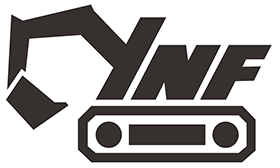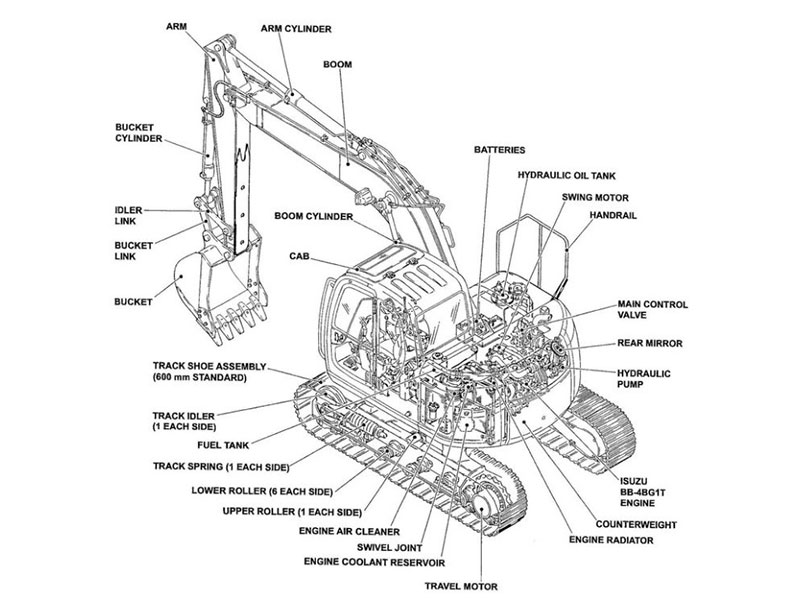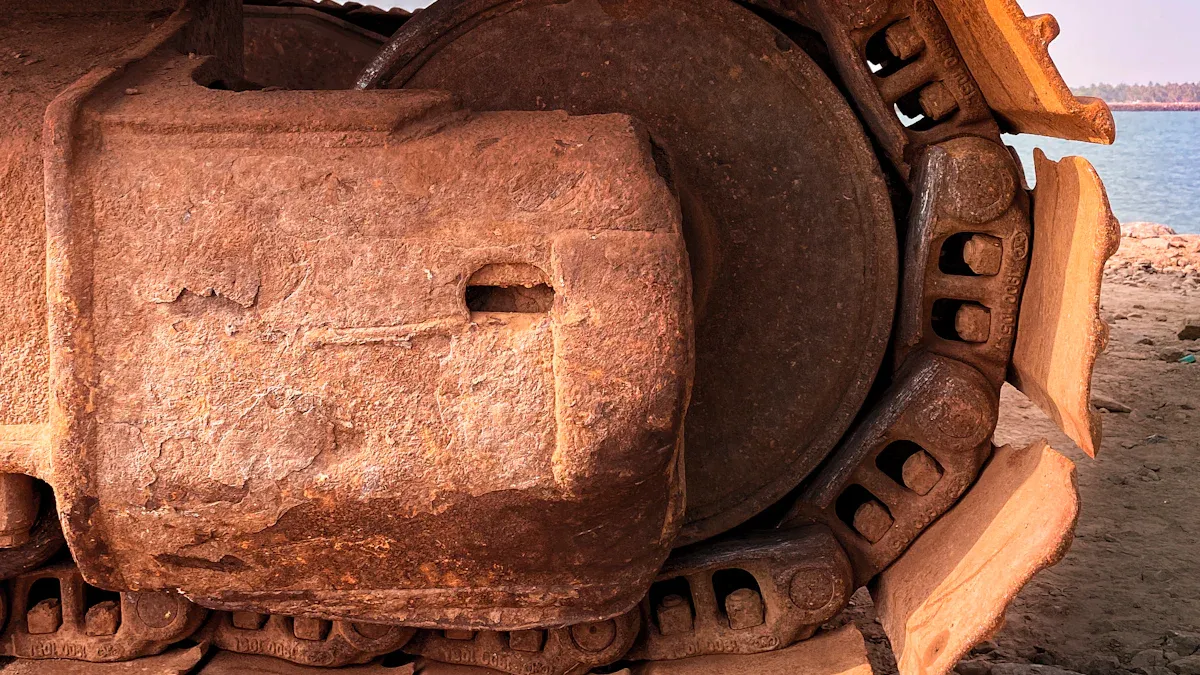
Choosing the right excavator repair parts keeps your machine safe. There are many choices because each brand and model needs special parts. Using the wrong part can hurt your equipment and waste money. The right excavator parts help stop breakdowns and save your investment. Always make sure the part fits your excavator, and buy from trusted places. This careful way helps your excavator stay in good shape and get the best use from the repair parts you buy.
Key Takeaways
Always check your excavator’s model and serial number first. This helps you buy the right parts and avoid expensive mistakes.
Look at your machine often for damage or things that are worn out. Use manuals and diagrams to find the exact parts you need to change.
Pick good quality parts, and use OEM for important pieces. Look for certifications like ISO9001 to make sure they are reliable.
Buy from a supplier people trust and who has a good name. Make sure they offer a clear warranty and helpful customer service. This keeps your money safe and stops delays.
Check part numbers closely and follow the right steps to install them. This helps your excavator last longer and saves you money later.
Confirm Model and Specs
You must know your machine’s model and specs before buying parts. This step helps you avoid mistakes. It makes sure you get the right excavator parts each time.
Locate Serial Number
First, find your excavator’s serial number. Look for it on a metal plate on the frame or under the cab. Some brands put it near the engine or on the main boom. The serial number shows the year, model, and sometimes the factory where it was made.
Tip: Write the serial number down. Keep it in your phone or notebook. This will help you when you order parts or talk to a dealer.
Check Compatibility
After you have the serial number, check your machine’s manual or the manufacturer’s website. Find a parts diagram or list for your model. This helps you pick the right excavator part for your machine. Many parts look alike but only fit certain models.
Match the part number from your manual with the part you want.
Ask your supplier to check if you are not sure.
Use online tools or apps from trusted brands to match parts.
Picking the right excavator part means fewer breakdowns and better work. You protect your investment and keep your machine working longer. Always check the specs before you buy, so you get the right excavator part every time.
Identify Needed Excavator Repair Parts
You must know which excavator repair parts your machine needs. If you pick the wrong part, it can make things worse and waste time. Excavators have many parts that work together. When one part breaks, the whole machine can have trouble. Always check which part is broken or worn before you order a new one.
Assess Wear and Damage
Check your excavator often to find problems early. Look for leaks, cracks, or worn spots on the hydraulic system, engine, and bucket. Listen for odd sounds when you use the machine. Touch parts to see if they feel too hot. These signs mean some parts may need fixing.
Look at moving parts like bucket teeth, pins, and bushings for wear.
Check hydraulic hoses and seals for leaks or cracks.
See if the engine has oil leaks or dirty filters.
Look at track chains and rubber tracks for cuts or missing pieces.
Make sure bolts on mini excavator parts and attachments are not loose or missing.
Tip: Use sensors and control systems if your excavator has them. These tools help you find problems before they get worse. They give you real-time data and warn you about hydraulic pressure, engine temperature, or other important parts.
Think about what causes parts to wear out. Bad weather, rough ground, and not enough oil can hurt your excavator repair parts. If you use your machine in tough places, check it more often. Preventive and predictive maintenance programs help keep your excavator in good shape. They remind you to change filters, check the engine, and look at protection systems.
Use Manuals and Diagrams
Your excavator’s manual is very helpful. It shows every part and how they fit together. Use the diagrams to find the right part number for the bucket, hydraulic pump, or engine filter you need. This helps you avoid mistakes when ordering mini excavator parts or other excavator repair parts.
Find the part of the manual that matches what you want to fix, like the engine or bucket.
Use the diagram to see how the parts connect.
Write down the part number and check it with your supplier.
A table can help you keep track of parts that often break and what to look for:
Area | Common Parts to Inspect | Signs of Wear |
|---|---|---|
Bucket | Teeth, pins, bushings | Chips, cracks, loose fit |
Hydraulic System | Hoses, seals, pump | Leaks, low pressure, noise |
Engine | Filters, belts, gaskets | Dirty filters, oil leaks |
Undercarriage | Track chains and rubber tracks | Cuts, missing links, wear |
Attachments | Mini excavator parts, couplers | Loose bolts, poor fit |
You should change common wear parts like filters, belts, seals, hoses, bucket teeth, and undercarriage parts on a set schedule. This keeps your excavator working well and helps you avoid big repairs. Always match the part number from the manual to the part you buy. This makes sure you get the right fit for your machine, whether you need mini excavator parts, hydraulic seals, or new bucket parts.
Note: If you use special excavator attachments, check their manuals too. Some attachments have special parts that need regular care.
If you follow these steps, your excavator repair parts will fit and last longer. You protect your investment and keep your excavator ready to work.
Check Part Quality
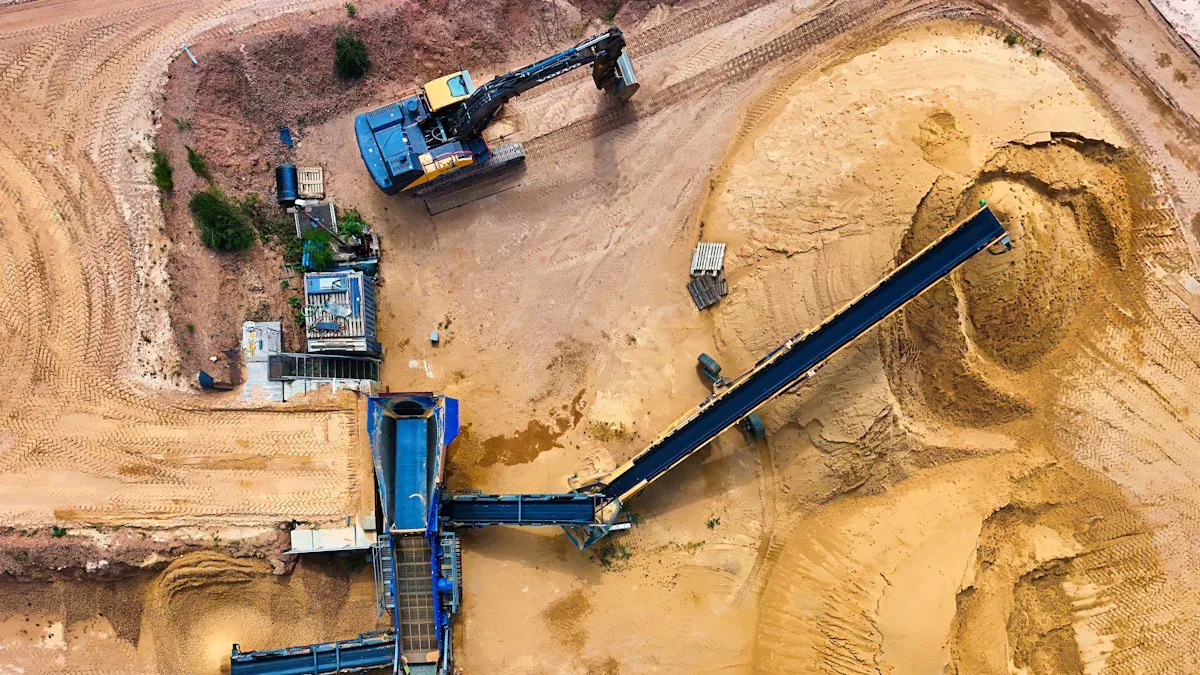
When you choose excavator repair parts, you need to check the quality before you buy. Good parts help your machine last longer and work better. You want to avoid problems that come from weak or poor-quality components. Here is how you can check the quality of the parts you need.
OEM vs Aftermarket
You will see two main types of parts: OEM and aftermarket. OEM stands for Original Equipment Manufacturer. These parts come from the same company that made your excavator. They fit well and match the machine’s original design. You can trust OEM parts for your hydraulic system, bucket, or engine because they meet the maker’s standards.
Aftermarket parts come from other companies. Some aftermarket components offer good value and work well. Others may not fit right or last as long. You need to check reviews and ask your supplier about the quality. Sometimes, aftermarket parts cost less, but you might spend more money later if they fail.
Tip: Use OEM parts for critical areas like the hydraulic pump, engine, or bucket teeth. You can use aftermarket parts for less important components, but always check their reputation first.
Material and Build
You should always look at the material and build of the part. Strong materials help your excavator work in tough places. For example, bucket teeth need hard steel to dig through rocks and dirt. Hydraulic hoses must handle high pressure and not crack. Engine filters should trap dirt and keep the engine clean.
Check if the part feels solid and heavy. Look for smooth welds and no sharp edges. Good components have even paint and no rust. If you see weak spots or thin metal, the part may not last long. Ask your supplier what materials they use for stock quality replacement components. You want parts that can handle daily work and rough conditions.
Here is a quick table to help you check the build of common excavator parts:
Part Type | What to Check For | Why It Matters |
|---|---|---|
Hydraulic hoses | Thick rubber, strong fittings | Stops leaks and bursts |
Bucket teeth | Hard steel, solid welds | Digs better, lasts longer |
Engine filters | Fine mesh, sturdy frame | Keeps engine safe from dirt |
Undercarriage | Heavy steel, no cracks | Handles weight and movement |
Pins and bushings | Smooth finish, no gaps | Reduces wear and noise |
Certifications
You should always check if the part has a quality certification. This helps you know the part meets high standards. The ISO9001 certification is one of the most important. Many top brands, like Komatsu, Hitachi, and Caterpillar, use ISO9001 for their chassis components and track links. This certification means the part was made with strict quality checks.
If you see ISO9001 on hydraulic, bucket, or engine components, you can trust that part more. Not all parts have this mark, but it is a good sign when you find it. Ask your supplier if their parts have ISO9001 or other quality marks. This step helps you avoid fake or weak parts.
Note: Certified parts may cost a bit more, but they help your excavator run better and last longer. You save money in the long run by avoiding breakdowns.
Choose the Right Excavator Parts Supplier
Choosing the right supplier for excavator repair parts is just as important as picking the right part. A good supplier helps you avoid delays, wasted money, and machine problems. You want a supplier with a strong track record and reliable support.
Supplier Reputation
You can check a supplier’s reputation by looking at several key indicators. Here are some ways to judge if a supplier is trustworthy:
Check how long the supplier has worked in the machinery industry. More experience often means better service.
See if the supplier offers a wide range of excavator parts. This shows they know the market well.
Review their contract terms and pricing. Fair and clear terms protect you from hidden costs.
Test their customer service. Good suppliers answer questions quickly and solve problems fast.
Inspect the condition of their parts. Well-maintained stock means better quality for you.
Try to contact them. Fast replies show they care about your needs.
Look at their paperwork. Organized documents make buying easier.
Ask about technical support. You may need help during installation or repairs.
Read reviews from other customers. Positive feedback builds trust.
See if they have awards or attend industry events. This shows they are active and respected.
Check their social media. Active pages mean they value customer relationships.
Tip: When buying used parts, always ask for maintenance records and check for signs of wear. Used parts can save money, but only if they fit your machine and last long.
Warranty and Returns
A good supplier stands behind their products. You should look for suppliers who offer a clear warranty. Most quality suppliers give a warranty from 3 months up to 1 year. This protects you if the part fails early. Ask about their return policy. Can you return or exchange the part if it does not fit or work? A fair return policy saves you from costly mistakes. Always read the warranty details before you buy.
Customer Support
Strong customer support makes your repair process easier. Here is what you should expect from a top supplier:
Fast delivery, usually within 3 to 5 days, so your machine gets back to work quickly.
Quality assurance, such as test reports or inspection videos, to prove the part is real and reliable.
Secure payment options and protection if something goes wrong with your order.
Free replacement or repair during the warranty period, giving you peace of mind.
If you choose a supplier with a good reputation, clear warranty, and strong support, you protect your investment and keep your excavator running smoothly.
Fit, Installation, and Value
Cross-Check Part Numbers
You must check you have the right excavator part before repairs. Always double-check part numbers in your manual or the supplier’s catalog. Service kits help you avoid mistakes because they have all needed parts, even small things like gaskets. You get everything from one place, which saves time and lowers mistakes. Each kit uses one reference number, so ordering and tracking is simple. The kit comes with clear instructions, so you do not have to guess during installation. This way, you can plan repairs and keep your spending under control.
Feature | Benefit |
|---|---|
Service kits have all needed parts, including small pieces like gaskets | Saves time by making sure you get the right parts from one supplier |
One reference number makes ordering and tracking easy | Speeds up ordering and helps stop mistakes when picking parts |
Kits come with simple, clear instructions | Helps mechanics install parts right and keeps downtime short |
Kits help you plan repairs and save money | Makes it easier to stick to your budget and avoid surprise costs |
Tip: Always match the part number in your manual with the number on the part or kit. This step helps you get the right excavator part every time.
Installation Tips
Installing parts the right way helps your machine last longer. Follow these steps for best results:
Check suction tubes often and use anti-cavitation valves to stop damage.
Keep hydraulic oil at the right level and change it as the manual says.
Look at hydraulic cylinders for leaks and fix them fast.
Use the correct filters and change them on time to keep fluids clean.
Let trained workers do repairs and maintenance for the best results.
If you follow these tips, you can stop early wear and keep your excavator safe.
Cost vs Value
Some parts cost less, but they may not be the best value. The right excavator parts last longer and work better. For example, Komatsu parts are made to be strong and last a long time. Cheaper brands might save you money at first, but you could pay more later for repairs. Good brands also give fast help and easy access to spare parts, so your machine does not stop working for long. Buying quality parts helps you get more work done and saves money over time.
Aspect | Evidence Summary |
|---|---|
Durability & Reliability | Komatsu parts are made to last longer than other brands. Cheaper parts may cost less now but need more repairs later. |
Post-sale Support | Komatsu gives quick help and fast spare parts, so your machine does not stop for long. |
Long-term Value | Buying original Komatsu parts helps you work better and make more money over time, even if they cost more at first. |
Remember, picking the right excavator parts means your machine works better and you save money in the end.
Excavator Types and Compatibility
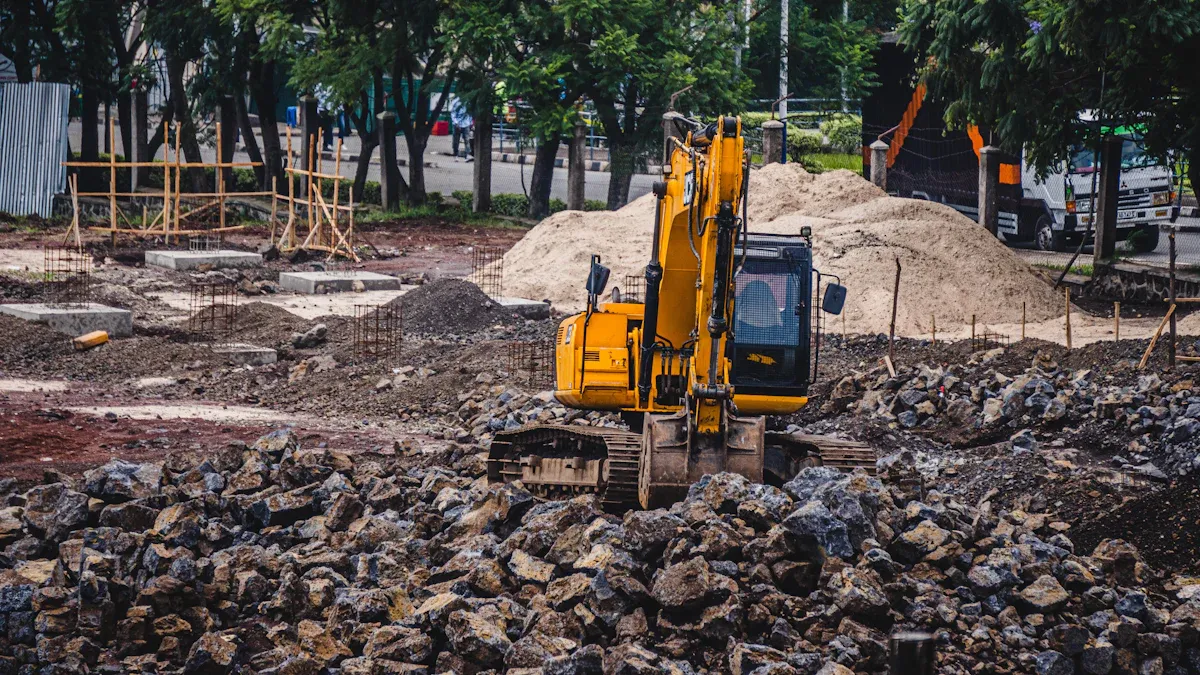
Match Parts to Excavator Types
You need to know about different excavator types before buying repair parts. Each type uses special parts that only fit certain models. Compact excavators are small and work well in tight spaces. You often see them on city jobs or in small areas. Midi excavators are a little bigger and can move more dirt. They are good for medium-sized jobs. Standard excavators are common on building sites. They can lift heavy things and dig deep holes. Large excavators are the biggest. You find them in mining or on huge construction projects.
Spare parts, like swing motor repair parts, are made for certain models. For example, a part for a PC200-8 will not fit other excavator types. You must use genuine or compatible parts to keep your machine working well. If you use the wrong part, your excavator might break down or not work right. Always check the model and size before you buy mini excavator parts or parts for large excavators.
Tip: Always match the part to your machine’s brand and model. This helps you avoid problems and keeps your excavator safe.
Check Specs (Bore, Pin Stroke, Hydraulics)
You must check the specs before you buy parts. Look at the bore size, pin stroke, and hydraulic system. Compact excavators and midi excavators have smaller bores and pins. Large excavators need bigger and stronger parts. The hydraulic system moves the arm, bucket, and boom. Each excavator type uses a different hydraulic setup. Mini excavator parts must fit the smaller hydraulic lines and pumps. Large excavators use heavy-duty hydraulic hoses and cylinders.
Here is a table to help you compare specs:
Excavator Type | Bore Size | Pin Stroke | Hydraulic System |
|---|---|---|---|
Compact excavators | Small | Short | Light-duty hydraulic |
Midi excavators | Medium | Medium | Medium hydraulic |
Standard excavators | Large | Long | Strong hydraulic |
Large excavators | Extra Large | Extra Long | Heavy-duty hydraulic |
If you use the wrong size or type, the part will not fit or work right. Always check the specs in your manual. This step helps you pick the right mini excavator parts, midi excavators parts, or parts for large excavators. You keep your machine safe and working well.
Remember, matching the right part to your excavator type and checking all specs helps you avoid costly mistakes. You get the best performance from your hydraulic system and your excavator lasts longer.
Picking the right excavator repair parts helps your machine work well. Follow these easy steps: 1. Make sure the part matches your model and check the specs. 2. Choose good parts, like original Cat components, for a better fit and longer use. 3. Buy from trusted suppliers and ask local dealers for help if you need it. 4. Change worn parts on time and use reminders to help you remember. 5. Try remanufactured parts if you want to save money but still get good results. Taking care of your machine and making smart choices keeps your machine safe and helps it work better.
FAQ
How do you know if a part is genuine or fake?
Look at the box for brand logos and serial numbers. Ask your supplier to show proof that the part is real. Real parts often have special certificates or shiny stickers called holograms. If you are not sure, talk to the company that made your excavator.
Can you use aftermarket parts on any excavator?
You can use aftermarket parts, but always make sure they fit your model. Some aftermarket parts work well and last a long time. Others might not fit right or break sooner. Read what other people say and ask your supplier for help before you buy.
How often should you replace common wear parts?
Change filters, belts, and bucket teeth every 500 hours or as your manual says. Check hoses and seals every time you do service. Doing regular checks helps you stop big problems before they happen.
What should you do if a part does not fit?
Stop putting the part in right away. Check the part number and your machine’s details again. Call your supplier for help or to return the part. Never try to force a part to fit because it can break your excavator.
